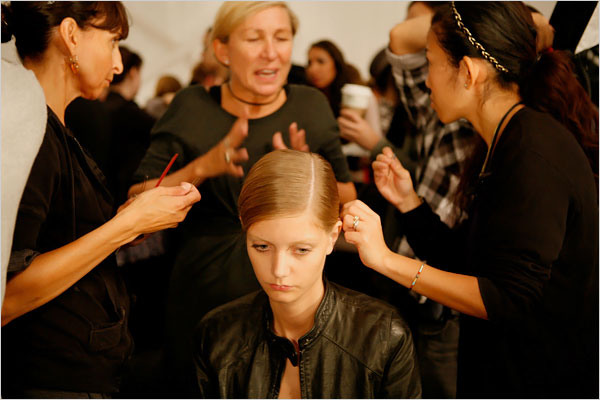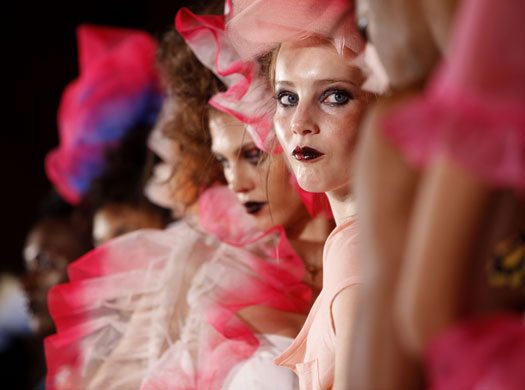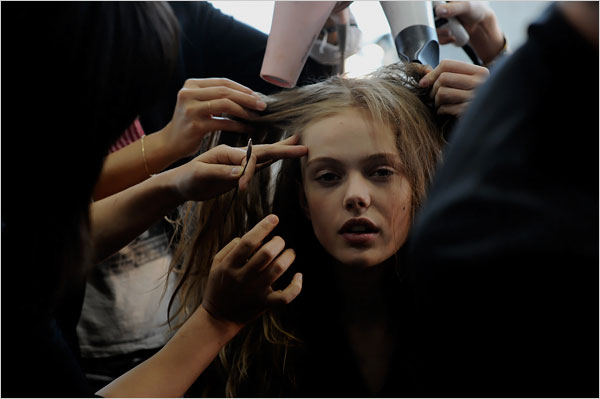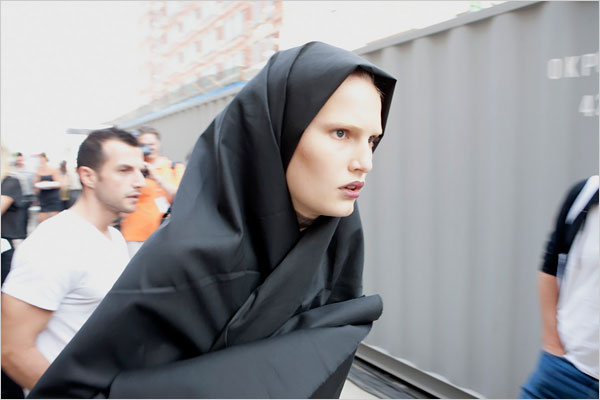It’s Fashion Week in New York, and more people than would admit to it are looking to see what bizarre costumes are being displayed this year. Most will never be seen again, of course, and good thing, too. And few of us would assume that the staged excess of runway culture could reveal much about the conditions of ordinary life. But the fashion shows, like any other theater, can expose what might be overlooked in our more practical activities.
Photographic coverage of the shows often tries to capture more than the fashions themselves, and perhaps more so this year when so many of the photos are coming from backstage. Too many of those are still contrived (especially in the New York Times series in the online Style section), but others catch more than the producers might want to show.

Elegant, yes; happy, not so much. One feature of this year’s photography is that there are a number of shots that suggest the other side of a model’s life: boredom, loneliness, and, most of all, realizing that you, as opposed to your look, are truly irrelevant. This forlorn waif seems to have learned that lesson all too well. She is surrounded by people who are intensely, passionately focused on her appearance while being completely oblivious to her. They could just as well be working on a mannequin.

This photo grabs me for the same reasons and more. There is a magical quality to the image, as if she were coming to life out of a row of inanimate figures. The truth may be just the opposite: she is being transformed into something inanimate, the line of identical models whose combined presence will wow the crowd precisely because, as in any fashion show, they have become interchangeable objects. This girl looks like she’s had a hard life anyway, and now she’s on the verge of disappearing. She could be appealing to someone to help her escape, but it’s more likely a last look back before she accepts her fate.

Perhaps it’s because she’s even younger than the others, but it could be the drugged expression: this could be a shot from one of those sick horror movies where teens are tortured and dismembered before they die. Again, others work intently on her exterior while, somewhere inside, a person sinks into oblivion. In a few more years, she can audition for another remake of the Stepford Wives, a role she already models.

Or it could come to this. A remarkable image, as she could be anything from a space alien to a woman religious. Or, combining both, the Bene Gesserit from Dune. Somehow the science fiction analogies seem stronger: perhaps it’s the face, which looks like it came out of a labratory for making replicants. (This would be the basic stock prior to individual customization.) Either way, she still has the hunted look of someone who lives inside a body that has to be styled for others. As with many other women trapped by fashion, you hope she might be able to find an unlocked door somewhere and slip away into an easier life.
Photographs by Erin Baiano/New York Times, Seth Wenig/AP, Jennifer Altman/New York Times, Greg Scaffidi/New York Times.
Our culture spends so much time banging on about women in burkhas and hajibs, making a phony excuse for wars based on misplaced notions of a westernised paternalistic pseudo-feminism, whilst at the same time celebrating the wholesale abuse of women in the fashion industry.
Thank you for this. 🙂
(And it’s DCAP time again! You not coming over this year?)
I’m a Fashion Week fan, as was probably clear in the Penn State workshop. But I’m rarely convinced that what appears on the runway does not influence fashion down the line. I remember that speech Meryl Streep makes in Devil Wears Prada about how the colors or fabrics used in the haute couture collections, which are never meant to be worn by people as part of their daily lives, trickles down over time to what appears in a department store’s bargain bins. I went to Kohl’s before the semester started to get a few things, and it seemed liked everything had been influenced by the Michael Kohrs collection from last fall. And that thought makes me happy since I loved this fall’s Bottega Veneta collection and can’t wait to see the influence it has on the clothes I buy at Target or Kohl’s or whatever next year.
What strikes me about these photos is that they seem to be showing a new trend away from the ethnic ambiguity that has characterized fashion modeling since 2000. These women are not just white but have their whiteness exaggerated. It’s been a while since I’ve seen that on the runway.
Ho hum. If your point is about the artifice of high fashion, I can buy into that. But please do not try to make me feel sorry for models. They choose their lives. They lust after those careers. Many of them embrace the emptiness through self-abuse and aggressive nothingness in their activities. Not blaming, just saying, it’s hard for me to work up energy about exploitation when young women are so very very good at exploiting themselves these days (ie, Girls Gone Wild, or just being fashion slaves). Unlike garment workers, models can walk away and do something else quite easily. They are actually somewhat more than hangers, they are sales agents, as anyone who watches Project Runway, or the seemingly endless shows that celebrate modeling, soon discovers.
“She is being transformed into something inanimate, the line of identical models whose combined presence will wow the crowd precisely because, as in any fashion show, they have become interchangeable objects” (Hariman). I think this statement hits this issue right on the head. While watching a fashion show or running through pages in a magazine, we often look at the surface of things and not at the whole picture itself. These photos capture the vulnerability of models; their loneliness, boredom and unsatisfied discontent. However, much of what was said in the description may be taking it a little too far. It does take quite the imagination just look at a picture of a model getting her hair and make-up done, with a dazed look on her face, and compare it to a teenager in a horror film getting “tortured and dismembered”. Or to say that the girl in the picture obviously looks like she’s had a hard life anyways, seems a little too broad of a statement. Who’s to know that she’s had a hard life?
I don’t know if I am someone who believes that you can tell a lot about a person through a photo. In some candid cases I definitely feel that photo’s can capture a current state of mind of a person, but when a photo is captured, who’s to say that the expression on the person’s face wasn’t just an act or just a bad candid moment captured? But thinking of it that way isn’t as fun as really analyzing every bit about the photo, like this website does. As a society, we are already aware of the stereotype of models; their eating habits, lifestyles, etc. This already acquired knowledge helps us to come to the conclusion that these photos are obviously capturing the inner-feelings of what these models are truly living with. So I feel that if you already know the background of these women’s lifestyles, then it is fair and accurate to say those broad statements about the individual.